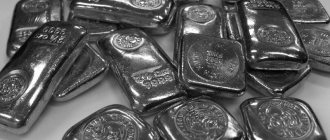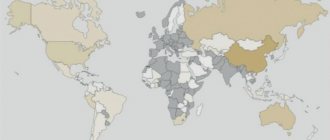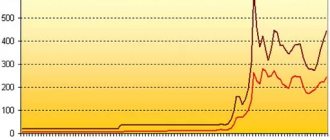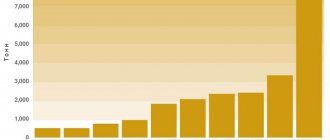Results of gold production in Russia in 2021
Supply and demand
Global gold demand fell 7% in 2021 to 4,071.7 tonnes.
The influx of gold into ETFs decreased significantly (by 63%) and amounted to 202.8 tons. The sharp decline in retail investment in the United States has reduced global demand for coins and bars. Purchases from central banks also decreased - by 5%, to 371.4 tons, the most active buyers were Russia and Turkey. The renewed demand for jewelry (an increase of 4%, to 2135.5 tons) was facilitated by purchases in India and China. The increased use of gold in smartphones and equipment led to an increase in industrial demand (by 3%, to 332.8 tons) - for the first time since 2010, demand for gold for technological needs showed positive dynamics.
Supply on the gold market in 2021 decreased by 4%, to 4398.4 tons. Production reached 3268.7 tons, while recycling of recyclable materials fell by 10%. Tightening environmental regulations in China (the world's largest producer) led to a 9% decline in gold production in the country. The global hedge portfolio decreased by 30.4 tons.
Table 1. Supply and demand on the gold market 2016-2017. (tons per year)
| 2017 | 2016 | % | |
| Offer | |||
| production | 3268,7 | 3263 | +0,2 |
| production hedging | -30,4 | +32,8 | |
| recycling | 1160 | 1295,1 | -10 |
| Total | 4398,4 | 4590,9 | -4 |
| Demand | |||
| Jewelry | 2135,5 | 2053,6 | +4 |
| Industrial | 332,8 | 323.4 | + 3 |
| Investment | 1231,9 | 1595,3 | -23 |
| -coins and bars | 1029,2 | 1048,7 | -2 |
| -ETF | 202,8 | 546,8 | -63 |
| Central banks | 371,4 | 389,8 | -5 |
| Total | 4071,7 | 4362,2 | -7 |
| Gold price (dollars per ounce) | 1257 | 1250 | |
Source: Prime with reference to WGC
China continues to hold the leading position in gold mining by a large margin. According to published data, gold mining companies in the Middle Kingdom produced about 440 tons of the yellow metal last year, recording a slight drop compared to 2021. Australia occupies second place in the ranking with 300 tons of gold production last year. The country increased its performance by 3.27%. The gold mining industry in Australia is a key industry in the country. Russia is in third place in the ranking of the world's largest gold miners with an annual production volume of 255 tons.
Table 2. Gold production in countries of the world, tons
| 2017 | 2016 | 2015 | 2014 | 2013 | 2012 | 2011 | 2010 | |
| China | 440 | 453,5 | 450 | 478 | 438 | 413 | 371 | 341 |
| Australia | 300 | 290,5 | 279,2 | 274 | 268 | 251 | 259 | 261 |
| Russia | 255* | 253,5 | 249,5 | 247 | 232 | 213 | 200 | 189 |
| USA | 245 | 236,0 | 218,2 | 209 | 230 | 231 | 233 | 231 |
| Indonesia | 80 | 168,2 | 176,3 | 116 | 111 | 89 | 120 | 140 |
| Canada | 180 | 165,0 | 159,0 | 152 | 133 | 108 | 108 | 104 |
| Peru | 155 | 164,5 | 175,9 | 173 | 188 | 180 | 188 | 185 |
| South Africa | 145 | 150 | 151 | 159 | 177 | 177 | 202 | 203 |
| Mexico | 110 | 120,5 | 135,8 | 118 | 120 | 101 | 89 | 79 |
| Ghana | 80 | 95,0 | 95,1 | 107 | 107 | 96 | 91 | 92 |
| Total in the world | 3150 | 3222 | 3208 | 3131 | 3042 | 2850 | 2829 | 2734 |
* — Extraction from mineral raw materials.
Source: 2010-2016
— magazine “Gold and Technologies”; 2021 - US Geological Survey Despite several years of declining production, Canadian mining company Barrick Gold Corporation remains an industry leader.
Barrick operates mining, exploration and development projects on four continents and has large land holdings in some of the world's richest and most promising mineral deposits. The company's vision is to be the world's best gold mining company by operating in a safe, profitable and responsible manner.
If the forecast for the current year comes true, the leader may be supplanted by Newmont Mining Corporation, a mining company from the United States. The company was founded in 1916 in New York by William Boyce Thompson as a diversified holding. Today, Newmont Mining Corporation is engaged in the development of ore deposits in various countries around the world - both independently and through ownership of shares in the authorized capital of industry companies. Unlike Barrick, Newmont's performance has been fairly stable in recent years.
AngloGold Ashanti is in third position in the ranking with a fairly significant lag. The company was formed in 2004 through the merger of AngloGold and Ashanti Goldfields Corporation. Today AngloGold has 20 projects in 10 countries on 4 continents. The majority of the company's assets are located in South Africa (43%).
Companies operating in Russia still lag quite significantly behind the leaders. There is hope that after the development of the Sukhoi Log deposit, Polyus will make a serious leap in the ranking, but it is too early to say anything concrete at this stage of development of the mine.
Table 3. Volume of gold production in leading public companies in the industry, tons
| 2013 | 2014 | 2015 | 2016 | 2017 | 2018 (forecast) | ||
| 1. | Barrick Gold, Canada | 222,9 | 194,3 | 190,2 | 171,6 | 164,8 | 155,5 |
| 2. | Newmont, USA | 157,5 | 150,7 | 156,6 | 161,7 | 161,7 | 167,9 |
| 3. | AngloGold Ashanti, South Africa | 127,5 | 138,1 | 119,1 | 112,8 | 118,2 | 105,7 |
| 4. | Goldcorp, Canada | 82,9 | 89,3 | 107,7 | 89,4 | 80,9 | 77,8 |
| 5. | Kinross Gold, Canada | 77,7 | 80,4 | 81,5 | 87,4 | 83,17 | 77,7 |
| 6. | Newcrest, Australia | 73,5 | 72,4 | 77,4 | 76,6 | 71,2 | |
| 7. | Gold Fields, South Africa | 58,1 | 69,0 | 67,2 | 66,7 | 68,4 | 65,9 |
| 8. | PJSC Polyus, Russia | 51,3 | 52,7 | 54,8 | 59,8 | 67,1 | 73,8-75,4 |
| 9. | Agnico Eagle Mines, Canada | 34,2 | 44,4 | 52,0 | 51,7 | 53,2 | |
| 10. | Sibanye Gold Ltd, South Africa | 44,5 | 49,4 | 47,8 | 47,0 | 37,1 | |
| 11. | Zijin Mining Group Co, China | 31,7 | 33,7 | 35,6 | 41,6 | 37,5 | |
| 12. | Yamana Gold, Canada | 32 | 37,2 | 39,6 | 39,4 | 25,6 | 31,4 |
| 13. | Randgold Resources Plc, UK | 28,3 | 35,7 | 37,7 | 39,0 | 40,9 | |
| 14. | Freeport-McMoRan, USA | 38,9 | 37,8 | 39,1 | 33,8 | 44,5 | |
| 15. | Harmony Gold, South Africa | 35,4 | 36,4 | 33,3 | 33,2 | 33,9 | |
| 16. | Glencore PLC, Switzerland | 31,5 | 30,6 | 29,5 | 31,9 | 62,2 | |
| 17. | Polymetal, Russia | 25 | 29,6 | 26,9 | 28,2 | 33,4 | |
| 18. | Nordgold, Russia | 29 | 30,6 | 29,5 | 27,0 | 30,1 | 29,5-31,1 |
Source: 2013-2016 — magazine “Gold and Technologies”; 2017 — company reports, media information, authors’ calculations
Exchange turnover
The main result of the year for the gold market was the metal overcoming the level of $1,300 per ounce, which allowed us to talk about a change in the previously established downward trend. The average gold price in 2017 was 1,257 per ounce, which is slightly higher (+0.4%) than in 2021.
Table 4. Average gold prices and exchange rates in 2010-2017.
| 2010 | 2011 | 2012 | 2013 | 2014 | 2015 | 2016 | 2017 | +, % | |
| Average price of gold dollars per ounce | 1224 | 1572 | 1669 | 1410 | 1266 | 1160 | 1251 | 1257 | +0,4 |
| Average price of gold rubles per gram | 1201 | 1494 | 1666 | 1435 | 1566 | 2280 | 2683 | 2357 | -12,2 |
| Average ruble to US dollar exchange rate | 30,36 | 29,39 | 31,09 | 31,2 | 38,4 | 61,4 | 66,8 | 58,34 | -12,7 |
| Ruble to US dollar exchange rate at the end of the year | 30,47 | 32,20 | 30,37 | 32,7 | 56,3 | 72,9 | 60,6 | 57,60 | -5 |
Source: 2010-2016 — magazine “Gold and Technologies”; 2017 — authors’ calculations
Figure 1. Spot gold quote daily chart of dollars per ounce
Despite the fact that gold quotes were in an upward trend for almost the entire 2021, they crossed the 200-period average for the first time, which is critical for ascertaining a change in trend, from bottom to top only in March and then repeatedly rolled back from the reached highs.
If we compare the volatility of gold with the volatility of other precious metals, it can be noted that its level was significantly lower than that of platinum and especially palladium. Gold in 2021 was not a profitable instrument for long-term investment.
Table 5. Average prices for precious metals in 2015-2017. (dollars/oz.).
| Precious metals | 2015 | 2016 | 2017 | % |
| Gold | 1160 | 1251 | 1257 | +0,4 |
| Silver | 15,68 | 17,14 | 17,05 | -0,5 |
| Platinum | 1053 | 987 | 917 | -7,1 |
| Palladium | 691,63 | 613,72 | 1014 | +65,2 |
Source: 2015-2016 — magazine “Gold and Technologies”; 2017 — authors’ calculations.
Russian Federation
According to the Ministry of Finance, gold production in Russia in 2017 amounted to 306.9 tons, which is 6% more than in 2016 (288.5 tons).
Production of mining gold increased by 6.3%, to 253.9 tons, associated gold by 11.1% to 16.4 tons, secondary gold by 4.5%, to 36.6 tons.
Table 6. Gold production in the Russian Federation in 2014-2017, kg
| 2014 | 2015 | 2016 | 2017 | |
| Dobychnoe | 230664 | 232341 | 238825 | 253900 |
| Along the way | 16240 | 16604 | 14754 | 16400 |
| Secondary | 35812 | 38474 | 35014 | 36600 |
| Total: | 282716 | 288991 | 288593 | 306900 |
Sources: 2014-2016 — magazine “Gold and Technologies”; 2017 - Ministry of Finance.
The most significant event in the Russian gold mining industry in 2017 occurred in January.
, in partnership with the Rostec state corporation, won an auction for the development of one of the largest gold deposits in the Russian Federation, Sukhoi Log.
The company also turned out to be among the stock market newsmakers: after delisting from the London Stock Exchange at the end of 2015, Polyus decided to list shares on the Moscow Stock Exchange, which attracted a wide range of investors from all over the world. The placement of shares helped the company get into the MSCI index.
At the end of May, the main shareholder of Polyus agreed to sell 10% of the company's shares to a Chinese consortium led by the Fosun investment fund for $886.9 million. The deal was to be completed by the end of 2017. The shareholders' agreement provided for a number of privileges for Fosun and its partners. They have veto power on company reorganization, liquidation, additional issue, reduction of dividend payments, transactions with related parties and buybacks. However, the deal did not take place; its termination was announced at the beginning of 2021.
In September, Vysochaishy launched the first production stage of the Taryn Mining and Processing Plant in Yakutia, and in October, the Ugakhan Mining and Processing Plant in the Irkutsk Region. Through these projects alone, the company plans to almost double its annual production volume by 2021 - up to 10 tons of gold.
Also in September, the Natalka field was launched, which a dozen years ago was considered the largest unexplored field in Russia. in 2014, she suspected something was wrong with its reserves when she did not receive the planned volume of gold when processing the first 10 million tons of ore.
It turned out that the Soviet data on the analysis of samples from the deposit were incorrect: and the information about the gold content in the ore was overestimated. In 2015, the company recalculated reserves and updated the field development model. As a result, reserve estimates were reduced by almost half. In December 2021, Polyus received the first doré bar from the deposit. It will reach full capacity at the end of this year.
In 2021, for the first time, the market started talking about a possible deal to acquire JSC Gold of Kamchatka from Renova of Viktor Vekselberg. In addition, there are grounds for renewed rumors about a possible merger of Kamchatka Gold with the Petropavlovsk company. For quite a long time, Renova increased its stake in the company, but only at the beginning of this year it joined forces with two affiliated funds, thus consolidating about 40% of the shares, and elected its candidates to the board of directors. At the same time, the founders of the company, Peter Hambro and Pavel Maslovsky, left Petropavlovsk.
In mid-March, one of the large domestic gold miners, Nordgold, after six years of public status, delisted from the London Stock Exchange. Before this, the company, which was more than 90% owned by businessman Alexei Mordashov, assessed the possibility of placing more shares on the market, but later came to the conclusion that its shares were greatly undervalued and decided to develop independently. The company continues to monitor the market and, if conditions are favorable, may return to public status after the launch of the Gross field in Yakutia in 2021.
Table 7. Gold production by companies operating in Russia, tons
| 2014 | 2015 | 2016 | 2017 | 2018 (forecast) | ||
| 1. | Polyus, PJSC | 52,66 | 54,8 | 59,82 | 67,11 | 73,8-75,41 |
| 2. | Polymetal Int.4 | 26,34 | 24,65 | 24,77 | 33,41 (44,5) | (48,2)1 |
| 3. | Kinross Gold6 | 21,31 | 21,69 | 20,69 | 83,171 (18) | 77,7 1 (15,2) |
| 4. | Yuzhuralzoloto GK, JSC | 7,28 | 12,98 | 14,55 | 153 | 153 |
| 5. | Petropavlovsk plc | 19,42 | 15,68 | 12,95 | 13,61 | 13,5-14,33 |
| 6. | Nordgold NV5 | 10,6 | 10,63 | 8,33 | 30,11 (7,38) | 29,5-31,11 |
| 7. | Highland Gold Mining | 6,71 | 6,58 | 6,92 | 8,461 | 6,7-73 |
| 8. | Gold of Kamchatka, OJSC | 1,52 | 2,34 | 5,49 | 5,173 | 5,2-5,53 |
| 9. | Vysochaishy, PJSC | 5,49 | 5,64 | 5,10 | 6,72 | 6,7-9,33 |
| 10. | Susumanzoloto, JSC | 3,97 | 4,23 | 4,53 | 5,082 | 53 |
| 11. | Seligdar, PJSC | 3,68 | 3,48 | 4,33 | 4,621 | 63 |
| 12. | Pavlik ZRK, JSC (IC "Arlan") | 0 | 1,07 | 3,66 | 6,52 | 6-6,53 |
| 13. | Zapadnaya GRK, a/s, CJSC | 2,6 | 2,88 | 3,25 | 3,093 | 3-3,23 |
| 14. | Concern "Arbat", JSC | 2,01 | 2,65 | 2,7 | 2,962 | 3,03 |
| 15. | Vitim, a/s, CJSC | 2,39 | 2,53 | 2,58 | 2,913 | 2,5-33 |
| 16. | Solovyovsky mine, JSC | 2,24 | 2,53 | 2,47 | 3,52 | 3,5-4,03 |
| 17. | Search Zoloto, JSC | 2,42 | 2,62 | 2,41 | 2,313 | 2,43 |
| 18. | Berelekh GDK, OJSC | 2,06 | 1,8 | 2,23 | 1,912 | 23 |
| 19. | Sibzoloto Holding | 1,81 | 2,383 | 2.33 | ||
| 20. | Amur Zoloto, LLC | 1,31 | 0,77 | 0,83 | 1,481 | 1,53 |
Source: 2014-2016
— “Gold and Technology” magazine. 1 – Company data 2 – Regional government data 3 – Website fomag.ru according to data from the Union of Gold Miners 4 – Gold equivalent in brackets 5 – In brackets – production at Russian divisions (estimated) 6 – In brackets – production at Russian divisions (company data)
Analyzing the regional structure of Russian gold mining, I would like to note the breakthrough of the Magadan region and the retreat of Chukotka.
In 2021, gold mining enterprises in the Magadan region produced 32,466 tons of gold, which is 19% more than the production in 2021, making the region the second largest producer of precious metals in Russia. The increase in production in the region was due to increased production at the Pavlik deposit and an increase in gold production from alluvial deposits.
Chukotka lost a quarter of its production and dropped from second place to seventh.
The decline is explained by a decrease in gold production at the Kupol, Dvoinoye and Valunistoye deposits, where there is a decrease in reserves and a decrease in gold content. Due to the decline in production, the region suffered significant budget losses.
Table 8. Gold production in Russian regions, kg
| 2012 | 2013 | 2014 | 2015 | 2016 | 2017 | % | |
| Krasnoyarsk region | 44001 | 47326 | 47236 | 49994 | 55058 | 58183 | +6 |
| Chukotka Autonomous Okrug | 17988 | 21361 | 30337 | 30548 | 28820 | 21466 | -25 |
| Magadan Region | 19587 | 21092 | 23847 | 23604 | 27314 | 32466 | +19 |
| The Republic of Sakha (Yakutia) | 20826 | 21951 | 23139 | 25344 | 23505 | 23648 | +1 |
| Amur region | 28671 | 30664 | 29312 | 25946 | 22863 | 26366 | +15 |
| Irkutsk region | 18921 | 20595 | 22112 | 22104 | 22502 | 22653 | +1 |
| Khabarovsk region | 14799 | 20416 | 20540 | 18225 | 19847 | 24410 | +23 |
| Transbaikal region | 8567 | 9452 | 9638 | 11219 | 12107 | 10822 | -11 |
| Chelyabinsk region | 5023 | 5300 | 5573 | 6742 | 7183 | 7129 | -1 |
| Kamchatka Krai | 2490 | 2214 | 2984 | 3604 | 6667 | 6377 | -4 |
| Sverdlovsk region | 7568 | 7604 | 7863 | 6411 | 6434 | 6118 | -5 |
| The Republic of Buryatia | 5989 | 5944 | 6857 | 6235 | 5988 | 5699 | -5 |
| Tyva Republic | 1425 | 1847 | 1936 | 2305 | 2371 | 1766 | -25 |
| The Republic of Khakassia | 1629 | 2199 | 2036 | 1736 | 1964 | 2192 | +12 |
| Sakhalin region | 118 | 104 | 93 | 1764 | 1582 | 1048 | -34 |
| Kemerovo region | 739 | 819 | 1008 | 1061 | 1487 | 1408 | -5 |
| Altai region | 1088 | 971 | 715 | 736 | 698 | 758 | +9 |
| Novosibirsk region | 256 | 296 | 400 | 251 | 323 | 340 | +5 |
| Altai Republic | 404 | 425 | 384 | 342 | 295 | 574 | +94 |
| Republic of Bashkortostan | 323 | 204 | 177 | 204 | 243 | 312 | +29 |
Source: 2012-2016 — magazine “Gold and Technologies”; 2017 — Assay Office
The main net buyer of domestic gold has been and remains the Central Bank of Russia. In 2021, the regulator bought about 224 tons of the precious metal, that is, approximately 73% of the volume produced in the country.
The activity of Russian commercial banks in the gold market is much more modest.
For example, reserves of precious metal in the vaults of Russian banks decreased from the beginning of September 2021 to the end of January this year by 38.5%, or by 28.2 tons, and amounted to 45 tons.
Sberbank reduced inventories during the reporting period by 13.5 tons, or 86.1%, VTB - by 13.3 tons, or 29%, Promsvyazbank - by 1.8 tons, or 93.7%.
VTB is in first place in terms of gold reserves as of February 1, 2021 (32.6 tons), Gazprombank is in second (4.1 tons), and FC Otkritie Bank is in third (2.4 tons).
Analysts note that the main buyer of gold from Russian commercial banks could be the Bank of Russia.
Table 9. Dynamics of gold purchases into the reserves of the Central Bank of the Russian Federation (2010-2017)
| date | The value of monetary gold in foreign currency (millions of US dollars) | Monetary gold (millions of fine troy ounces) | Gold reserves (tons) | Increase in reserves in tons compared to the previous year (%) |
| 01/01/2010 | 22 798 | 20,9 | 649,1 | |
| 01/01/2011 | 35 788 | 25,4 | 788,6 | 21,49 |
| 01/01/2012 | 44 697 | 28,4 | 883,0 | 11,97 |
| 01/01/2013 | 51 039 | 30,8 | 957,8 | 8,47 |
| 01/01/2014 | 39 990 | 33,3 | 1 035,2 | 8,08 |
| 01/01/2015 | 46 089,0 | 38,8 | 1 206,8 | 16,58 |
| 01/01/2016 | 48 562,6 | 45,5 | 1 415,21 | 17,27 |
| 01/01/2017 | 60 193,6 | 51,9 | 1 614,27 | 14,07 |
| 01/01/2018 | 76 647,0 | 59,1 | 1 838,22 | 13,9 |
Source: according to the Central Bank of the Russian Federation
Table 10 Dynamics of gold purchases for the reserves of the Central Bank of the Russian Federation (2017 by month)
| date | The value of monetary gold in foreign currency (millions of US dollars) | Monetary gold reserves (millions of fine troy ounces) | Gold reserves (tons)* |
| 01/01/2017 | 60 193,6 | 51,9 | 1 614,27 |
| 02/01/2017 | 62 935,7 | 52,9 | 1 645,37 |
| 03/01/2017 | 66 862,9 | 53,2 | 1 654,71 |
| 04/01/2017 | 67 569,7 | 54,0 | 1 679,59 |
| 05/01/2017 | 68 653,1 | 54,2 | 1 685,81 |
| 06/01/2017 | 69 295,3 | 54,9 | 1707,58 |
| 07/01/2017 | 68 770,2 | 55,2 | 1716,91 |
| 08/01/2017 | 70 037,5 | 55,6 | 1729,35 |
| 09/01/2017 | 73 499,6 | 56,1 | 1744,91 |
| 10/01/2017 | 73 603,5 | 57,2 | 1779,12 |
| 01.11.2017 | 73 704,9 | 57,9 | 1800,89 |
| 12/01/2017 | 76 118,2 | 58,8 | 1828,88 |
| 01/01/2018 | 76 647,0 | 59,1 | 1838,22 |
Source: according to the Central Bank of the Russian Federation
At the end of last year, Russian jewelers increased their consumption of gold for making products by 10.4% compared to 2021 - to 33.46 tons.
In total, 31.18 million pieces of jewelry containing 34.72 tons of pure gold passed through the Assay Chamber of Russia last year.
Specialists of the Assay Chamber noted that 2021 was the first year in the last few years of growth in buyer interest in gold jewelry and platinum products.
Exports of refined gold from the Russian Federation in 2021 increased by more than 2.5 times compared to 2021 and amounted to 56.6 tons.
Forecast for 2021
According to the Union of Gold Miners of Russia, gold mining and production in Russia in 2021 will increase and amount to 328 tons.
Gold production from mineral raw materials this year may increase to 293 tons due to an increase in gold production at the Natalka deposit, the Taryn and Ugakhan mining and processing plants reaching their design capacity, as well as the resumption of operation of heap leaching plants at the Birkachan deposit and the Kuranakh ore field.
Production growth will be facilitated by the extraction of the first gold at the Gross deposit, as well as the launch of a gold recovery plant at the Verkhne-Aliinsky gold deposit.
Associated gold production in 2021 may increase to 21 tons as the Bystrinsky GOK reaches its design capacity with an increase in associated gold in concentrate.
At the same time, the production of secondary gold in 2021 may decrease to 35 tons.
As for the forecast for gold prices, according to experts, two factors will influence the situation.
The first is due to the fact that current prices are not so far from the average cost of gold production ($900-1100 per ounce). This means that a number of companies are operating on the edge of profitability and overall supply may be slowly shrinking. Thus, even with constant demand, a moderate increase in quotations can be expected. The second factor will be determined by the effectiveness of Donald Trump's tax reform and the Fed's policy in general. The growing American economy can act as a powerful support.
Based on this, we can expect gold prices to be around $1,400-$1,500 per ounce.
The largest gold mining companies operating in Russia are generally positive about the prospects for 2021.
A few months ago, it revised its forecast for gold production in 2021, increasing it to 2.375 - 2.425 million ounces against the previously announced 2.35 -2.40 million. Revenue for the year is estimated at $2,684 million.
Polymetal confirmed production plans for 2021 and 2019 of 1.55 million and 1.7 million gold equivalent ounces, respectively.
Significant investments will be directed towards the completion of the Kyzyl project and the project to increase the productivity of the Amur MMC. The company also plans to accelerate the development of feasibility studies for the Nezhdaninskoye field and AGMK-2 projects.
Nordgold forecasts gold production for the current year to range from 950 thousand to 1 million ounces.
The company's capital expenditures in 2021 will be approximately $390 million, including investments in the construction of the Gross mine in Russia, exploration, development and maintenance of projects, as well as capitalized stripping activities.
The material was prepared by the editorial staff.
Published in the magazine “Gold and Technology” No. 1(39)/March 2018
Tags:
Analytics,
Gold mining results
Plus 110 jobs
A subsidiary of the Seligdar polymetallic holding, Artel Prospectors Poisk, mines ore gold at the Murzinsky deposit (formerly the Demidov mine).
This is the largest employer in the Krasnoshchekovsky district. About 300 people work here. 98 of them are residents of the region, the rest are visitors from other regions who work on a rotational basis, said Alexander Bobryshev. Among the shift workers, in particular, are highly qualified specialists. And some of the visitors even buy housing in the area.
According to the head of the district, the commissioning of the gold extraction factory, which is currently under construction, will lead to the creation of 110 new jobs.
Alexander Bobryshev, head of the Krasnoshchekovsky district.
Altairegion22.ru










